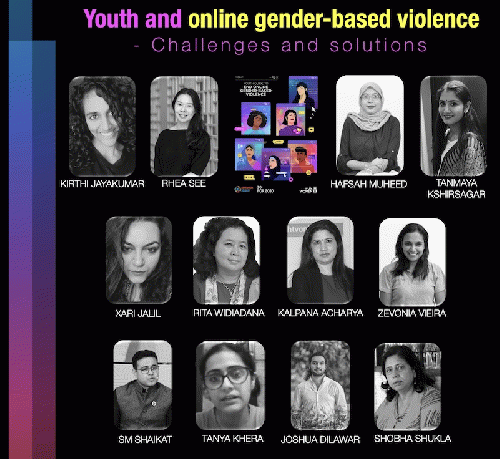SHOBHA SHUKLA - CNS
Gender-based violence is among the most prevalent human rights violations globally. Urgency is palpable as governments worldwide have less than 7 years to end all forms of gender-based violence and deliver on the promise of gender equality for all by 2030. But instead of declining, gender-based violence has become even more sinister and complex because technology-based and technology-facilitated online gender-based violence is also on an alarming rise.
Online gender-based violence is casting a long, oppressive shadow on the freedom and safety of women, girls, and gender-diverse individuals globally. Also, the impact of gender-based violence committed in the virtual space is increasingly spilling over into offline real spaces, sometimes with severe consequences.
Most of the online violence goes unreported
According to a study, the overall global prevalence of online violence against women was estimated to be 85% in 2021. The corresponding figure for the Asia Pacific region was 88%, with adolescent girls and those from vulnerable backgrounds disproportionately affected. And yet most of it goes unreported. Only 1-in-4 women reported online violence to the online platform(s) on which it occurred, while only 14% reported it to any offline protective agency. More than half (54%) of the women who reported personally experiencing online violence knew the perpetrator. Nearly 75% of women surveyed expressed concern about online abuse escalating to offline threats.
Online gender-based violence is a multi-headed monster
Hafsah Muheed, who is an intersectional feminist and human rights advocate from Sri Lanka, is a member of the 30 for 2030 network hosted by UN Women Asia Pacific. She explained in the Gender Equality Talks that online gender-based violence can take several forms, such as:
- Cyber-flashing: targeting persons for their sex, gender, or sexual orientation by sending unsolicited photographs with the intent of silencing a person.
- Cyberstalking: surveillance of a person through digital technology. It is often used to prevent victims from escaping an abusive situation, like domestic and intimate partner violence.
- Doxing: disclosure of personal data online with malicious intents.
- Sextortion: extorting sexual favours by threatening to disseminate a person's intimate images and footage of rape.
- Zoom bombing: people joining online gatherings to post racist, sexist, pornographic or anti-Semitic content to shock and disturb viewers.
- Impersonation and creation of fake profiles by posing as a person to others, either acting in a harmful manner or extorting money from those the target knows.
- Morphing, superimposing, and splicing photographs or videos of the targeted person to create "deep fakes" and uploading them on pornographic platforms.
- Non-consensual dissemination of intimate photos, videos and audios of the targeted person, along with threats to circulate these images with the intent of blackmailing the target.
- Online sexual harassment and bullying in the form of messaging, emailing, calls, and direct-messaging through a variety of online platforms.
- Online threats to share information about an individual (including images or videos) to the public, their friends or family online, unless a demand is met. And many other forms!
"Online gender-based violence is a mirror of some form of violence happening in our offline world - by way of attitudes, and by the way we behave with one another. We are a patriarchal and an ableist society, because of which we have wrongly 'normalised' harmful narratives, social norms or attitudes," rightly said Kirthi Jayakumar, a women's rights activist, researcher, peace educator, lawyer and writer. She founded and runs The Gender Security Project and is the Head of Community Engagement at World Pulse.
Anonymity, which is one of the elements of online violence, "is a deciding factor on how the recurrence or prevalence of someone harassing you online or committing any form of online violence, multiplies by unimaginable numbers," said Tanmaya Kshirsagar, an Indian classical vocalist, writer, and an intersectional feminist. She is also part of 30 for 2030 Network of UN Women Asia Pacific.
How online gender-based violence impacts us
There is documented evidence to show that survivors of online gender-based violence have experienced emotional and physical harm, sexual assault, femicide (in the form of so called 'honour killings'), and even suicide.
It results in social isolation, with the survivor withdrawing from public life, including their family and friends. Girls skip or drop out of school to avoid bullying connected to online gender-based violence, and women have quit their jobs as a result of it. Survivors tend to delete accounts or quit online platforms altogether. It thus restricts their freedom of expression and increases the digital gender divide.
Media's role in combating online violence
Media must play a role in minimizing online violence by promoting digital literacy, raising awareness, initiating gender sensitive education, and advocating for a strong legal framework, added Nepal's former President of Health Journalists Association Kalpana Acharya. Media must combat harmful narratives and social norms within itself as well as through its channels - and this includes all forms of online violence.
"Indonesia is experiencing a surge in cases of online gender-based violence since the last few years. A report from the National Commission on Women states that cases of online gender-based violence have risen by 300% since 2021. The Woman National Commission Annual Records 2021 showed that online gender-based violence during the pandemic era had increased manifold - from 241 cases in 2019 to 940 cases in 2020," said Rita Widiadana, former Editor of The Jakarta Post, and Board member of Global AMR Media Alliance (GAMA) and Asia Pacific Media Alliance for Health and Development.
The National Commission and the Indonesian Press Council stated that women journalists in Indonesia face a high risk of experiencing both offline and online gender-based violence while carrying out their journalistic duties, said Rita.
Rita shared that Indonesia has implemented a number of programmes to protect girls and women against online violence such as SafeNet Programme; Perempuan Aman Internetan (How to use Internet safely for women); Respect (UN Women, WHO, UNFPA, and other partners); among others. The Indonesian government has also enacted laws which guarantee the right to protect personal data. But there are no clauses in this law that specifically protect survivors of sexual violence in cyberspace. Rita called upon revising this law so that survivors of online gender-based violence can receive full protection against cyber criminals.
Xari Jalil, a senior journalist and Editor of VoicePK (prominent digital media for human rights in Pakistan) said that women journalists are facing offline and online violence even within the media houses. "Most women have been targeted by some form of online gender-based violence whether it is revenge porn, or other forms," said Xari. She shared a case study of a "woman who was victim of revenge porn and killed herself leaving her children behind" - another grim reminder of serious consequences of virtual violence.
Online attack against gender diverse peoples in Timor-Leste
Cyber-bullying and harassment is on the rise in Timor-Leste for girls, women and LGBTQIAP+ peoples, said Zevonia Vieira, Chief Editor of Neon Metin Media and President of Association of Journalists of Timor-Leste. She stressed upon the need for better digital security training and the campaign against a draft cybercrime law in her country, which she believes is more aligned with political interests rather than protecting people's rights.
What do the youth say?
Bangladesh enacted a law in early 2000s to address online violence against women and girls but it was not enough. Cyber Security Act (CSA) which was being discussed recently also became more of a political instrument, said SM Shaikat of SERAC-Bangladesh. "We have to look at these laws in a different way: is it working for those more at risk of online violence among women, girls, gender diverse peoples, and others?"
(Note: You can view every article as one long page if you sign up as an Advocate Member, or higher).






